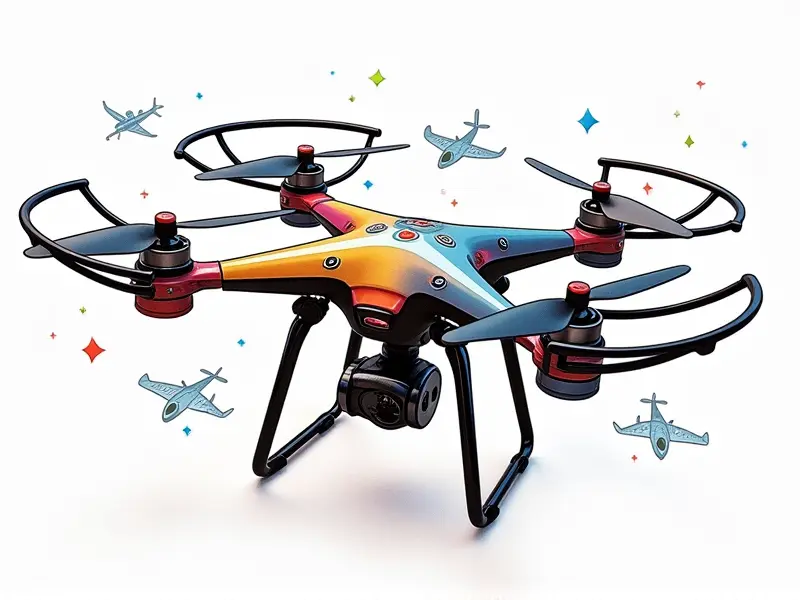Build an autonomous drone

Build Your Own Autonomous Drone from Scratch
Building your own autonomous drone is a fascinating project that combines electronics, programming, and aerodynamics. This guide will walk you through the process of creating a fully functional autonomous quadcopter or airplane.
DIY Autonomous Drone Project Guide
This comprehensive guide covers everything from selecting components to coding flight algorithms. Whether you're a beginner or an experienced hobbyist, this project is designed for anyone interested in robotics and unmanned aerial vehicles (UAVs).
Step-by-Step Autonomous Drone Construction
- Selecting Components: Choose the right motors, ESCs, flight controller, battery, and frame.
- Assembly: Assemble the drone's frame, install motors, ESCs, and other hardware.
- Wiring: Connect all components to the flight controller and power distribution board (PDB).
- Programming: Write code for autonomous navigation using GPS, IMU sensors, and onboard computer systems.
Creating an Autonomous RC Quadcopter
An autonomous quadcopter can perform tasks such as aerial photography, surveying, or delivery services. This section will focus on building a robust quadcopter that can operate without direct human intervention.
Selecting the Right Components for Your Autonomous Drone
- Motors: Brushless motors provide high efficiency and power-to-weight ratio.
- Flight Controller: A flight controller like Pixhawk or ArduPilot manages stability, navigation, and communication.
- Battery: High-capacity LiPo batteries ensure long flight times.
How to Make an Autonomous FPV Racing Drone
FPV racing drones offer a thrilling experience by providing real-time video feedback. This section will guide you through building an autonomous drone that can race autonomously, enhancing the excitement and complexity of your project.
Setting Up First-Person View (FPV) System
- Camera: Choose a high-resolution camera for clear video transmission.
- Video Transmitter: Ensure reliable signal strength and low latency.
- Goggles or Monitor: Use FPV goggles or an external monitor to view the live feed.
Constructing an Intelligent Flying Machine
An intelligent flying machine utilizes advanced sensors and algorithms for autonomous operation. This section will delve into integrating sophisticated navigation systems, such as GPS and IMU, to create a smart drone capable of complex missions.
Navigational Systems Integration
- GPS: Utilize GPS modules for precise location tracking.
- Inertial Measurement Unit (IMU): Combine accelerometer and gyroscope data to maintain stability.
- Lidar: Add Lidar sensors for obstacle detection and avoidance.
Build a Smart Autonomous Quadcopter
A smart autonomous quadcopter is equipped with advanced features like machine learning, real-time path planning, and adaptive control systems. This section will explore the intricacies of building such an intelligent drone.
Machine Learning for Drone Navigation
- Data Collection: Gather flight data to train your machine learning model.
- Model Training: Use algorithms like neural networks to predict optimal flight paths.
- Integration: Integrate the trained model into the drone's onboard computer system.
Easy Steps to Autonomize Your Drone
This section provides a concise guide on how to convert your existing RC drone into an autonomous one. Follow these simple steps to add autonomy features and enhance its capabilities.
Adding Autonomous Features to Existing Drones
- Install Flight Controller: Mount the flight controller and connect it to the ESCs.
- Configure Firmware: Set up the firmware for autonomous modes like waypoint navigation or follow-me.
- Test Autonomy: Fly your drone in autonomous mode and fine-tune settings as needed.
Building Smart, Autonomous Flying Machines
This section covers advanced topics such as integrating artificial intelligence (AI) and machine learning into drones for enhanced autonomy. Explore the possibilities of creating intelligent flying machines that can adapt to changing environments.
Integrating AI and Machine Learning
- Data Processing: Process sensor data using onboard computing power.
- Prediction Models: Develop models for predicting future states based on current conditions.
- Adaptive Control Systems: Implement systems that adjust flight parameters in real-time.
Constructing an Autonomous RC Airplane
An autonomous RC airplane can perform various tasks, from aerial photography to scientific research. This section will guide you through building a fully autonomous fixed-wing aircraft capable of long-range missions.
Selecting the Right Components for Your Autonomous Plane
- Propulsion System: Choose an efficient engine or electric motor suitable for your plane's design.
- Aerodynamic Design: Optimize wing shape and tail configuration for stability and performance.
- Navigational Systems: Integrate GPS, IMU, and other sensors for autonomous flight control.
Beginner's Guide to Autonomous Drones
If you're new to building drones, this section provides a gentle introduction to the basics of constructing an autonomous drone. Follow these steps to get started on your journey into the world of unmanned aerial vehicles.
Getting Started with Drone Building
- Understand Basic Concepts: Learn about aerodynamics, electronics, and programming.
- Gather Necessary Tools: Acquire tools like soldering iron, multimeter, and screwdrivers.
- Follow Online Tutorials: Watch video guides and read articles to gain practical knowledge.
Conclusion
Building an autonomous drone is a rewarding endeavor that combines technical skills with creativity. By following this guide, you'll be able to construct a sophisticated UAV capable of performing various tasks autonomously. Whether you're interested in aerial photography, scientific research, or just the thrill of flying, building your own autonomous drone opens up endless possibilities.

